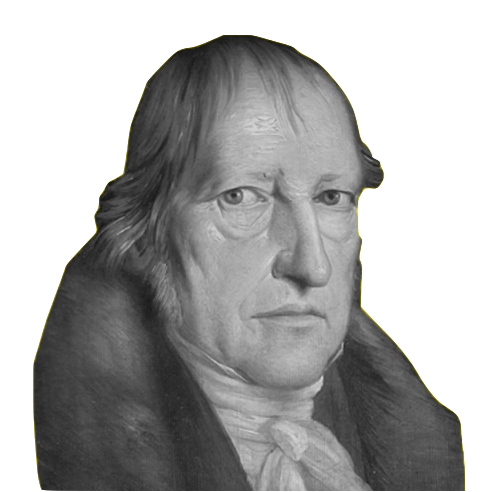G.W.F. Hegel con Chucho o Perrito


ヘーゲルと犬
G.W.F. Hegel con Chucho o Perrito


池田光穂
●蘇る犬としてのヘーゲル
Georg Wilhelm Friedrich Hegel - "Along with J.G. Fichte and, at least in his early work, F.W.J. von Schelling, Hegel (1770–1831) belongs to the period of German idealism in the decades following Kant. The most systematic of the post-Kantian idealists, Hegel attempted, throughout his published writings as well as in his lectures, to elaborate a comprehensive and systematic philosophy from a purportedly logical starting point. He is perhaps most well-known for his teleological account of history, an account that was later taken over by Marx and “inverted” into a materialist theory of an historical development culminating in communism. While idealist philosophies in Germany post-dated Hegel (Beiser 2014), the movement commonly known as German idealism effectively ended with Hegel’s death. Certainly since the revolutions in logical thought from the turn of the twentieth century, the logical side of Hegel’s thought has been largely forgotten, although his political and social philosophy and theological views have continued to find interest and support. Since the 1970s, however, a degree of more general philosophical interest in Hegel’s systematic thought and its logical basis has been revived." cited from the Stanford Encyclopedia of Philosophy.
「ゲオルク・ヴィルヘルム・フリードリヒ・ヘーゲル「J.G.フィヒテや、少なくとも初期の
著作においてはF.W.J.フォン・シェリングとともに、ヘーゲル(1770-1831)はカント以降の数十年間におけるドイツ観念論の時代に属する。カ
ント以後の観念論者の中で最も体系的であったヘーゲルは、出版された著作や講義を通じて、論理的な出発点から包括的かつ体系的な哲学を構築しようとした。
ヘーゲルはおそらく、歴史に関する彼の目的論的な説明で最もよく知られている。この説明は後にマルクスによって引き継がれ、共産主義を頂点とする歴史的発
展に関する唯物論へと「反転」した。ドイツにおける観念論哲学はヘーゲルより後であるが(Beiser
2014)、一般にドイツ観念論として知られる運動は、ヘーゲルの死とともに事実上終了した。確かに、20世紀に入ってからの論理思想の革命以来、ヘーゲ
ルの思想の論理的側面はほとんど忘れ去られてきたが、彼の政治哲学や社会哲学、神学的見解は関心を集め、支持され続けてきた。しかし1970年代以降、
ヘーゲルの体系的思想とその論理的基礎に対する、より一般的な哲学的関心が復活してきた。」
■悟性(Verstand)による暴力的介入、それ は分離である
「分離の活動は、悟性という、[すなわち]最も驚嘆 に価し[あらゆるもののうちで]もっとも大きい威力、あるいはむしろ絶対的な[威力]のもつ力であり労働である」——ヘーゲル(序論『精神現象学』原著 29ページ)
Die Tätigkeit des Scheidens ist die Kraft und Arbeit des Verstandes, der verwundersamsten und größten, oder vielmehr der absoluten Macht.
The activity of separation is the power and working of the mind, the most astonishing and greatest, or rather the absolute power.
「分けるというはたらきは悟性、最も不思議で偉大 で、あるいはむしろ絶対的な威力である悟性の力であり仕事である」樫山欽四郎訳、平凡社ライブラリー版(上):48ページ。
■悟性が遂行する分離について:あるいは悟性と犬について
「悟性が遂行する分離はまさに「奇跡的なこと」であ
る。なぜならば、この分離は実際「自然に反して」いるからである。悟性の介入がないならば、「犬」という本質は実在する犬において、そしてそれにより現存
在するにすぎぬであろうし、実在する犬のほうが、逆にその現存在自体によって一義的にこの本質を規定するであろう。だからこそ犬と「犬」という本質との関
係は「自然的」或いは「直接的」と言いうるのであるが、悟性の絶対的威力により本質が意味となり、一つの語の中に組み込まれるとき、もはや本質とその支え
との間には語を除いては「自然的な」関係は存在しなくなる。そして、音声上或いは書法上、その他何か時間的空間的に実在するものとしては相互に何の共通点
をもたぬさまざまの語(chien, dog, Hund
など)は、たとえそのすべてが唯一にして同一の意味をもちうるとしても、唯一にして同一の本質に支えるものとしては何ら役立つものではないのである。した
がって、ここには(本質と現存在との間の「自然的」な関係を含めた)在るがままの所与の否定があった、すなわち(概念、ないし意味をもつ語、しかも、語と
しては、それ自体からは、その中に込められた意味と何の関係ももたない語の)創造があった、すなわち行動ないし労働があったのである」。
——アレクサンド
ル・コージェブ(Alexandre
Kojève)「ヘーゲル哲学における死の概念」p.381『ヘーゲル読解入門』上妻精・今野雅方訳、国文社、1987年。
● On Hegels' Chucho as his "Science of
Logic" - all the citations from "Georg Wilhelm
Friedrich Hegel, of The Stanford Encyclopedia of Pilosophy"
"Hegel’s Science of Logic is divided into three books, dealing with the topics of being, essence, and the concept, which appeared in 1812, 1813, and 1816 respectively...."
"A glance at the table of contents of Science of Logic reveals the same triadic structuring among the categories or thought determinations discussed that has been noted among the shapes of consciousness in the Phenomenology. At the highest level of its branching structure there are the three books devoted to the doctrines of being, essence, and concept, while in turn, each book has three sections, each section containing three chapters, and so on. In general, each of these individual nodes deals with some particular category. In fact, Hegel’s categorial triads appear to repeat Kant’s own triadic way of articulating the categories in the Table of Categories (Critique of Pure Reason A80/B106) in which the third term in the triad in some way integrates the first two. (In Hegel’s terminology, he would say that the first two were sublated [aufgehoben] in the third—while the first two are negated by the third, they continue to work within the context defined by it.) Hegel’s later treatment of the syllogism found in Book 3, in which he follows Aristotle’s own three-termed schematism of the syllogistic structure, repeats this triadic structure as does his ultimate analysis of its component concepts as the moments of universality, particularity, and singularity."
Sublated [aufgehoben] - 止揚、審理中、未決
「ヘーゲルの『(大)論理学』は、存在、本質、概念を扱った3冊の本に分かれてお り、それぞれ1812年、1813年、1816年に刊行された。」
「『論理学』の目次を見ると、『現象学』における意
識の形と同じように、論じられるカテゴリーや思考の決定が三項構造になっていることがわかる。その枝分かれ構造の最も高いレベルには、存在、本質、概念の
教義に捧げられた3冊の本があり、順番に、各本には3つのセクションがあり、各セクションには3つの章がある、といった具合である。一般に、これらの個々
の節はそれぞれ、ある特定のカテゴリーを扱っている。実際、ヘーゲルの範疇の三項対立は、範疇の表(純粋理性批判A80/B106)において、三項対立の
第三項が何らかの形で最初の二項を統合するという、カント自身の範疇の三項対立的な表現方法を繰り返しているように見える。(ヘーゲルの用語法では、最初
の2つが第3項において昇華[aufgehoben]され、最初の2つは第3項によって否定されるが、それらは第3項によって定義された文脈の中で働き続
ける)。ヘーゲルは、アリストテレス自身の三段論法的図式に従った第3巻に見られるように、この三段論法的構造を繰り返し、その構成概念を普遍性、特殊
性、特異性の瞬間として究極的に分析している」
リンク
文献
その他の情報
Do not paste, but [re]think this message for all undergraduate students!!!